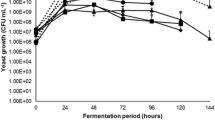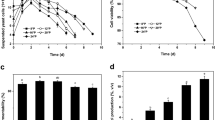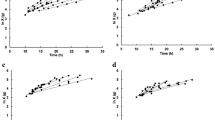Abstract
The volumetric productivity of the beer fermentation process can be increased by using a higher pitching rate (i.e., higher inoculum size). However, the decreased yeast net growth observed in these high cell density fermentations can have a negative impact on the physiological stability throughout subsequent yeast generations. The use of different oxygen conditions (wort aeration, wort oxygenation, yeast preoxygenation) was investigated to improve the growth yield during high cell density fermentations and yeast metabolic and physiological parameters were assessed systematically. Together with a higher extent of growth (dependent on the applied oxygen conditions), the fermentation power and the formation of unsaturated fatty acids were also affected. Wort oxygenation had a significant decreasing effect on the formation of esters, which was caused by a decreased expression of the alcohol acetyl transferase gene ATF1, compared with the other conditions. Lower glycogen and trehalose levels at the end of fermentation were observed in case of the high cell density fermentations with oxygenated wort and the reference fermentation. The expression levels of BAP2 (encoding the branched chain amino acid permease), ERG1 (encoding squalene epoxidase), and the stress responsive gene HSP12 were predominantly influenced by the high cell concentrations, while OLE1 (encoding the fatty acid desaturase) and the oxidative stress responsive genes SOD1 and CTT1 were mainly affected by the oxygen availability per cell. These results demonstrate that optimisation of high cell density fermentations could be achieved by improving the oxygen conditions, without drastically affecting the physiological condition of the yeast and beer quality.





Similar content being viewed by others
References
Aries V, Kirsop BH (1977) Sterol synthesis in relation to growth and fermentation by brewing inoculated at different concentrations. J Inst Brew 83:220–223
Barker MG, Smart KA (1996) Morphological changes associated with the cellular aging of a brewing strain. J Am Soc Brew Chem 54:121–126
Boulton C (2000) Trehalose, glycogen and sterol. In: Smart KA (ed) Brewing yeast fermentation performance, 1st edn. Blackwell Science, Oxford, pp 10–19
Boulton C, Quain D (2001) Brewing yeast and fermentation. Blackwell Science, Oxford
Boulton C, Clutterbuck V, Durnin S (2000) Yeast oxygenation and storage. In: Smart KA (ed) Brewing yeast fermentation performance, 1st edn. Blackwell Science, Oxford, pp 140–151
Casey GP, Magnus CA, Ingledew WM (1984) High-gravity brewing: effects on nutrition on yeast composition, fermentative ability and alcohol production. Appl Environ Microbiol 48:639–646
Chatterjee MT, Khalawan SA, Curran BPG (2000) Cellular lipid composition influences stress activation of the yeast general stress response element (STRE). Microbiology 146:877–884
Depraetere SA, Winderickx J, Delvaux FR (2003) Evaluation of the oxygen requirement of lager and ale yeast strains by preoxygenation. MBAA TQ 40:283–289
Edelen CL, Miller JL, Patino H (1996) Effects of yeast pitch rates on fermentation performance and beer quality. MBAA TQ 33:30–32
Erten H, Tanguler H, Cakiroz H (2007) The effect of pitching rate on fermentation and flavour compounds in high gravity brewing. J Inst Brew 113:75–79
Estruch F (2000) Stress-controlled transcription factors, stress-induced genes and stress tolerance in budding yeast. FEMS Microbiol Rev 24:469–486
European Brewery Convention (1998) Analytica-EBC. Fachverlag Hans Carl, Nürnberg
Fuji T, Kobayashi O, Yoshimoto H, Furukawa S, Tamai Y (1997) Effect of aeration and unsaturated fatty acids on expression of the Saccharomyces cerevisiae alcohol acetyltransferase gene. Appl Environ Microbiol 63:910–915
Fujiwara D, Yoshimoto H, Sone H, Harashima S, Tamai Y (1998) Transcriptional co-regulation of Saccharomyces cerevisiae alcohol acetyl transferase gene ATF1 and Δ-9 fatty acid desaturase gene OLE1 by unsaturated fatty acids. Yeast 14:711–721
Gibson BR, Lawrence SJ, Boulton CA, Box WG, Graham NS, Linforth RST, Smart KA (2008) The oxidative stress response of a lager brewing yeast strain during industrial propagation and fermentation. FEMS Yeast Res 8:574–585
Grauslund M, Didion T, Kielland-Brandt MC, Andersen HA (1995) BAP2, a gene encoding a permease for branched-chain amino acids in Saccharomyces cerevisiae. Biochim Biophys Acta 1269:275–280
Guldfeldt LU, Arneborg N (1998) The effect of yeast trehalose content at pitching on fermentation performance during brewery fermentations. J Inst Brew 104:37–39
Herrero E, Ros J, Bellí G, Cabiscol E (2008) Redox control and oxidative stress in yeast cells. Biochim Biophys Acta 1780:1217–1235
Higgins VJ, Beckhouse AG, Oliver AD, Rogers P, Dawes IW (2003) Yeast genome-wide expression analysis identifies a strong ergosterol and oxidative stress response during the initial stages of an industrial lager fermentation. Appl Environ Microbiol 69:4777–4787
Ivorra C, Perez-Ortin JE, del Olmo M (1999) An inverse correlation between stress resistance and stuck fermentations in wine yeasts. Biotechnol Bioeng 64:698–708
Jahnke L, Klein HP (1983) Oxygen requirements for formation and activity of the squalene epoxidase in Saccharomyces cerevisiae. J Bacteriol 155:488–492
Jamieson DJ (1998) Oxidative stress responses of the yeast Saccharomyces cerevisiae. Yeast 14:1511–1527
Jones DL, Petty J, Hoyle DC, Hayes A, Oliver SG, Riba-Garcia I, Gaskell SJ, Stateva L (2005) Genome-wide analysis of the effects of heat shock on a Saccharomyces cerevisiae mutant with a constitutively activated cAMP-dependent pathway. Comp Funct Genom 5:419–431
Kajiwara S, Aritomi T, Suga K, Ohtaguchi K, Kobayashi O (2000) Overexpression of the OLE1 gene enhances ethanol fermentation by Saccharomyces cerevisiae. Appl Microbiol Biotechnol 53:568–574
Kodama Y, Omura F, Miyajima K, Ashikari T (2001) Control of higher alcohol production by manipulation of the BAP2 gene in brewing yeast. J Am Soc Brew Chem 59:157–162
Kwast KE, Burke PV, Poyton RO (1998) Oxygen sensing and the transcriptional regulation of oxygen-responsive genes in yeast. J Exp Biol 201:1177–1195
Majara N, O’Connor-Cox ESC, Axcell BC (1996) Trehalose—a stress protectant and stress indicator compound for yeast exposed to adverse conditions. J Am Soc Brew Chem 54:221–227
Martin CE, Oh C-S, Jiang Y (2006) Regulation of long chain unsaturated fatty acid synthesis in yeast. Biochim Biophys Acta 1771:271–285
Martinez-Pastor MT, Marchler G, Schüller C, Marchler-Bauer A, Ruis H, Estruch F (1996) The Saccharomyces cerevisiae zinc finger proteins Msn2p and Msn4p are required for transcriptional induction through the stress-response element (STRE). EMBO J 15:2227–2235
Masschelein CA, Andries M, Franken F, Van de Winkel L, Van Beveren PC (1995) The membrane loop concept: a new approach for optimal oxygen transfer into high cell density pitching yeast suspensions. In: Proceedings of the European Brewery Convention (Brussels), 25th edn. IRL Press, Oxford, pp 377–386
M’Baya B, Karst F (1987) In vitro assay of squalene epoxidase of Saccharomyces cerevisiae. Biochim Biophys Res Commun 147:556–564
Moonjai N, Verstrepen KJ, Delvaux FR, Derdelinckx G, Verachtert H (2002) The effect of linoleic acid supplementation of cropped yeast on its subsequent fermentation performance and acetate esters. J Inst Brew 108:227–235
Nakagawa Y, Sugioka S, Kaneko Y, Harashima S (2001) O2R, a novel regulatory element mediating Rox1p independent O2 and unsaturated fatty acid repression of OLE1 in Saccharomyces cerevisiae. J Bacteriol 183:745–751
Neves MJ, Jorge JA, François JM, Terenzi HF (1991) Effects of heat shock on the level of trehalose and glycogen, and on the induction of thermotolerance in Neurospora crassa. FEBS Lett 283:19–22
Ohno T, Takahashi R (1986) Role of wort aeration in the brewing process. Part 1: oxygen uptake and biosynthesis of lipid by the final yeast. J Inst Brew 92:84–87
Okabe M, Katoh M, Furugoori F, Yoshida M, Mitsui S (1992) Growth and fermentation characteristics of bottom brewer’s yeast under mechanical stirring. J Ferment Bioeng 73:148–152
Pérez-Torrado R, Gómez-Pastor R, Larsson C, Matallana E (2009) Fermentative capacity of dry active wine yeast requires a specific oxidative stress response during industrial biomass growth. Appl Microbiol Biotechnol 81:951–960 doi:https://doi.org/10.1007/s00253-008-1722-9
Powell CD, Van Zandycke SM, Quain D, Smart KA (2000) Replicative ageing and senescence in Saccharomyces cerevisiae and the impact in brewing fermentations. Microbiology 146:1023–1034
Powell CD, Quain D, Smart KA (2003) The impact of brewing yeast cell age on fermentation performance, attenuation and flocculation. FEMS Yeast Res 3:149–157
Quain DE (1988) Studies on yeast physiology—impact on fermentation performance and product quality. J Inst Brew 95:315–323
Rautio JJ, Huuskonen A, Vuokko H, Vidgren V, Londesborough J (2007) Monitoring yeast physiology during very high gravity wort fermentations by frequent analysis of gene expression. Yeast 24:741–760
Saerens SMG, Verbelen PJ, Vanbeneden N, Thevelein JM, Delvaux FR (2008) Monitoring the influence of high-gravity brewing and fermentation temperature on flavour formation by analysis of gene expression levels in brewing yeast. Appl Microbiol Biotechnol 80:1039–1051 doi:https://doi.org/10.1007/s00253-008-1645-5
Shen H-Y, Moonjai N, Verstrepen KJ, Delvaux F, Delvaux FR (2003) Immobilization of Saccharomyces cerevisiae induces changes in the gene expression levels of HSP12, SSA3 and ATF1 during beer fermentation. J Am Soc Brew Chem 61:175–181
Smith A, Ward MP, Garrett S (1998) Yeast PKA represses Msn2p/Msn4p-dependent gene expression to regulate growth, stress response and glycogen accumulation. EMBO J 17:3556–3564
Sohal RS, Weindruch R (1996) Oxidative stress, caloric restriction, and aging. Science 273:59–63
Suihko M-L, Vilpola A, Linko M (1993) Pitching rate in high gravity brewing. J Inst Brew 99:341–346
Swan TM, Watson K (1998) Stress tolerance in a yeast sterol auxotroph: role of ergosterol, heat shock proteins and trehalose. FEMS Microbiol Lett 169:191–197
Van Loon APGM, Pesold-Hurt B, Schatz G (1986) A mutant lacking mitochondrial manganese-superoxide dismutase is hypersensitive to oxygen. Proc Natl Acad Sci USA 83:3820–3824
Van Zandycke SM, Sohier PJ, Smart KA (2002) The impact of catalase expression on the replicative lifespan of Saccharomyces cerevisiae. Mech Age Dev 123:365–373
Vasconcelles MJ, Jiang Y, McDaid K, Gilooly L, Wretzel S, Porter DL, Martin CE, Goldberg MA (2001) Identification and characterization of a low oxygen response element (LORE) involved in the hypoxic induction of a family of S. cerevisiae genes: implication for the conservation of oxygen sensing in eukaryotes. J Biol Chem 276:14374–14384
Verbelen PJ, Van Mulders S, Saison D, Van Laere S, Delvaux F, Delvaux FR (2008) Characteristics of high cell density fermentations with different lager yeast strains. J Inst Brew 114:127–133
Verbelen PJ, Dekoninck TML, Saerens SMG, Van Mulders SE, Thevelein JM, Delvaux FR (2009a) Impact of pitching rate on yeast fermentation performance and beer flavour. Appl Microbiol Biotechnol 82:155–167 doi:https://doi.org/10.1007/s00253-008-1779-5
Verbelen PJ, Depraetere SA, Winderickx J, Delvaux FR, Delvaux F (2009b) The influence of yeast preoxygenation prior to brewery fermentation on yeast metabolism and the oxidative stress response. FEMS Yeast Res 9:226–239 doi:https://doi.org/10.1111/j.1567-1364.2008.00476.x
Verstrepen KJ, Derdelinckx G, Dufour J-P, Winderickx J, Thevelein JM, Pretorius IS, Delvaux FR (2003a) Flavor-active esters: adding fruitiness to beer. J Biosci Bioeng 96:110–118
Verstrepen KJ, Van Laere SDM, Vanderhaegen BMP, Derdelinckx G, Dufour J-P, Pretorius IS, Winderickx J, Thevelein JM, Delvaux FR (2003b) Expression levels of the yeast alcohol acetyltransferase genes ATF1, Lg-ATF1, and ATF2 control the formation of a broad range of volatile esters. Appl Environ Microbiol 69:5228–5237
Villanueba KD, Goossens E, Masschelein CA (1990) Subthreshold vicinal diketone levels in lager brewing yeast fermentations by means of ILV5 gene amplification. J Am Soc Brew Chem 48:111–114
Willaert R (2007) The beer brewing process: wort production and beer fermentation. In: Huie YH (ed) Handbook of food products manufacturing, 1st edn. Wiley, New Jersey, pp 443–506
Willaert R, Nedovic VA (2006) Primary beer fermentation by immobilised yeast—a review on flavour formation and control strategies. J Chem Technol Biotechnol 81:1353–1367
Winderickx J, De Winde JH, Crauwels M, Hino A, Hohmann S, Van Dijck P, Thevelein JM (1996) Regulation of genes encoding subunits of the trehalose synthase complex in Saccharomyces cerevisiae: novel variations of STRE-mediated transcriptional control? Mol Gen Genet 252:470–482
Yamauchi Y, Okamoto T, Murayama H, Kajino K, Amikura T, Hiratsu H, Nagara A, Kamiya T, Inoue T (1995) Rapid maturation of beer using an immobilized yeast bioreactor. 1. Heat conversion of α-acetolactate. J Biotechnol 38:101–108
Zähringer H, Burgert M, Holzer H, Nwaka S (1997) Neutral trehalase Nth1p of Saccharomyces cerevisiae encoded by the NTH1 gene is a multiple stress responsive protein. FEBS Lett 412:615–620
Zitomer RS, Carrico P, Deckert J (1997) Regulation of hypoxic gene expression in yeast. Kidney Int 51:507–513
Acknowledgements
The authors wish to thank Stefan Van Loy for the excellent help with the experiments. Financial support from the Institute for the Promotion of Innovation through Science and Technology in Flanders (IWT-Vlaanderen) is acknowledged.
Author information
Authors and Affiliations
Corresponding author
Rights and permissions
About this article
Cite this article
Verbelen, P.J., Saerens, S.M.G., Van Mulders, S.E. et al. The role of oxygen in yeast metabolism during high cell density brewery fermentations. Appl Microbiol Biotechnol 82, 1143–1156 (2009). https://doi.org/10.1007/s00253-009-1909-8
Received:
Revised:
Accepted:
Published:
Issue Date:
DOI: https://doi.org/10.1007/s00253-009-1909-8




